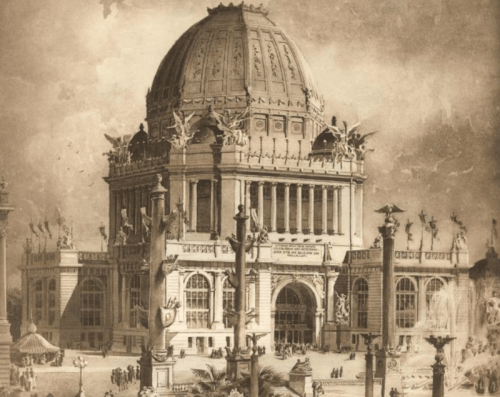‘Hunt’ing Down History, Part 14
By Barbara Emery Moseley
NOTE: This series chronicles the generations of Vernon’s Hunt family, all related to Jonathan Hunt of “Governor Hunt Road” fame. If you’ve missed any installments in this series, you can catch up here!
ILLUSTRATION: World’s Columbian Exposition Administration Building, Chicago, 1893, designed by Richard Morris Hunt
With only two years to create a “dream city” in what was Chicago’s derelict Jackson Park, Richard Morris Hunt and Frederick Law Olmsted were almost in a state of despair. It was a square mile of desolate land overgrown with a tangle of wild vines and grasses, spotted with a few pockets of various kinds of oaks, many of them dead. Then, there was the soil: a top one-foot layer of black dirt, followed by two feet of sand, then eleven feet of sand so saturated by water it became quicksand. Locally, it was called “gumbo”.
After a dismal tour in the bitter wind, everyone returned to their carriages, driving back to the city at the pace of a funeral cortege. McKim found a telegram awaiting; the message was that his mother had died. He left immediately on the next train to Boston.
That evening, the entire committee convened at the University Club, the first of many lavish dinners that would take place. Avoiding a swarm of reporters, they entered the banquet hall. Hunt and Olmsted were ushered to the head table, where they flanked Lyman Gage, President of the Exposition. All were in tuxedos, and a red rose boutonniere was at each place.
An 11-course meal followed, beginning with oysters and ending with ice cream. Interspersed were wines appropriate to the course. Broiled shad, filet mignon, and woodcock on toast were the meats. Speeches and toasts prolonged the meal.
The next day, they met again, electing Hunt their chairman. He was irritable; the trip from New York, and the depressing visit to Jackson Park had aggravated his gout; it soon confined him to his hotel room.
At the meeting, the architects agreed on a uniform neoclassical style, with columns and pediments reflecting Rome or Athens. They also made the decision that the uniform height of the cornice would be 60 feet. Walls, roofs and domes could be added above that height, but the even rows of cornices would unite the buildings ina pleasing harmony. It was Hunt’s idea. Different architect assumed the design of the Fair’s main structures. All would be of wood and painted white, illuminated inside and out with electric lamps with white globes.
McKim had returned, bringing with him Augustus St. Gaudens, one of the country’s noted sculptors, whose studio had recently been moved from New York City, to Cornish, New Hampshire. However, it was Daniel Chester French, with a studio in New York City and Stockbridge, Massachusetts, who was chosen to create the large “Statue of the Republic”, an 111 foot tall gilded female figure, including its pedestal. It became known as “Big Mary”, and she towered over the Central Court.
Then, individual architects walked to the front of the room, unrolled their drawings, displaying them on a wall. It became evident they were enthralled as each design was revealed. They spoke almost in whispers. Each building seemed more grand and beautiful than the last. All were immense, on a scale never before attempted.
Hobbling to the front of the room, Hunt displayed his design of the Administration Building, the most important at the Fair, and through which most visitors would enter. In its center was an octagon tower, topped by a dome that rose 275 feel from the floor to its peak, even higher than the dome of the U.S. Capitol.
Architect George B. Post’s design of the Manufacturers and Liberal Arts Building was even bigger. Its framework would use enough steel to build two Brooklyn Bridges. Twelve electric elevators would carry visitors to the upper levels. (Elisha Graves Otis was born in Halifax, Vermont, in 1811. He invented automatic safety grips for his elevators and also patented a steam elevator.) Four elevators would service the central tower, where visitors could exit at the fourth floor, emerging to an outside promenade where they could overlook the entire fairgrounds and vast Lake Michigan, in the distance.
Drawings continued to be unrolled as each architect revealed the design of his assigned building. The room was still, except for the speaker describing his plan. At the conclusion, Lyman Gage, the tall, straight-backed, conservative banker stood up. In a voice trembling with emotion, he said: “You are dreaming, gentlemen, dreaming. I only hope that half this vision can be realized.”
Meanwhile, America’s best mechanical engineers had been scrambling to design something that would outdo the Eiffel Tower, the marvel of the 1867 Paris Exposition. At last, success was at hand. The invention would require the largest one-piece casting ever made at Bethlehem Steel. Can you guess?

